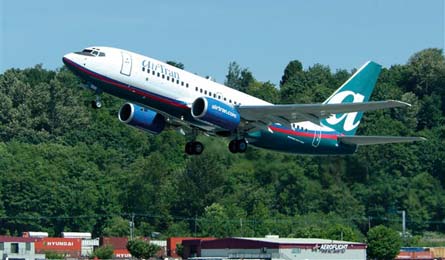US low-fare carrier AirTran Airways has suspended 14 aircraft deliveries previously scheduled for 2009 in an attempt to keep growth flat to combat what it deems as volatile energy costs.
To illustrate that volatility AirTran VP Finance and Treasurer Arne Haak today during an earnings call with analysts pointed to a wide range of fuel costs during the last six-to-seven months. At the end of September oil prices per barrel were $80, compared with $117 at the end of last week.
Similar to both its fellow US low-fare carriers and network airlines, AirTran today supplied its revised growth plan to analysts, indicating flat available seat mile growth during the later part of this year and in 2009.
 |
|---|
© AirTran |
AirTran plans year-over-year capacity growth of 10%-12% during the second quarter, with 9%-10% growth in July and August. Starting n September AirTran plans flat growth, down from previous estimated available seat mile growth of 10%.
For 2009, AirTran expects its capacity to remain flat year-over-year, down from previous growth estimates of 10%.
To support those reductions AirTran is cutting its fleet by six aircraft this year, which should result in a yearend fleet count of 141 aircraft versus previous projections of 147 planes.
The Atlanta-hubbed carrier has already firmed up sales of four Boeing 737-700s, and is in the process of solidifying agreements to sell an additional two aircraft of the same fleet type.
AirTran has not determined the exact framework for cutting the additional 14 aircraft scheduled to enter the fleet next year.
Senior VP marketing and planning Kevin Healy tells ATI that the carrier is in discussions with Boeing about deferrals and is also considering additional aircraft sales.
In the short-term, AirTran says the sale of the four 737-700s this year will improve planned cash flow by over $40 million through cash gains on the sale and the avoidance of equity investments in the aircraft, explains Haak.
The sale of those four aircraft also eliminates the need for AirTran to issue an additional $120 million in aircraft debt, says Haak.
AirTran’s estimated capacity growth for the spring and summer of this year reflects the seasonality of some its business. Haak estimates the carrier can be modestly profitable with oil prices in the low $100s per barrel, depending on the revenue environment and what happens with capacity in the marketplace.
Commenting on the general industry environment AirTran CEO Robert Fornaro believes that generally average fares will rise as “redundant capacity leaves” and that during the second and third quarters average fares are likely to rise at AirTran.
The carrier should benefit from some pull-down by major Atlanta rival Delta Air Lines during the summer timeframe. Senior VP Healy estimates Delta’s capacity out of Atlanta to destinations west of the Mississippi should post a double-digit drop during that time.
Seasonal flights ending during the shoulder months of autumn will also support some of AirTran’s flat growth during the later part of the year.
AirTran could also redistribute some of its existing capacity into its stronger markets. Fornaro explains that routes launched when oil prices per barrel were in the $50-$60 range “don’t hold up” at prices that are $100 per barrel or higher.
Pointing to Florida, Atlanta and Baltimore as key strong points in AirTran’s network, Fornaro says efforts to diversify in route development at high fuel prices will slow.
Source: Air Transport Intelligence news
Source: FlightGlobal.com























